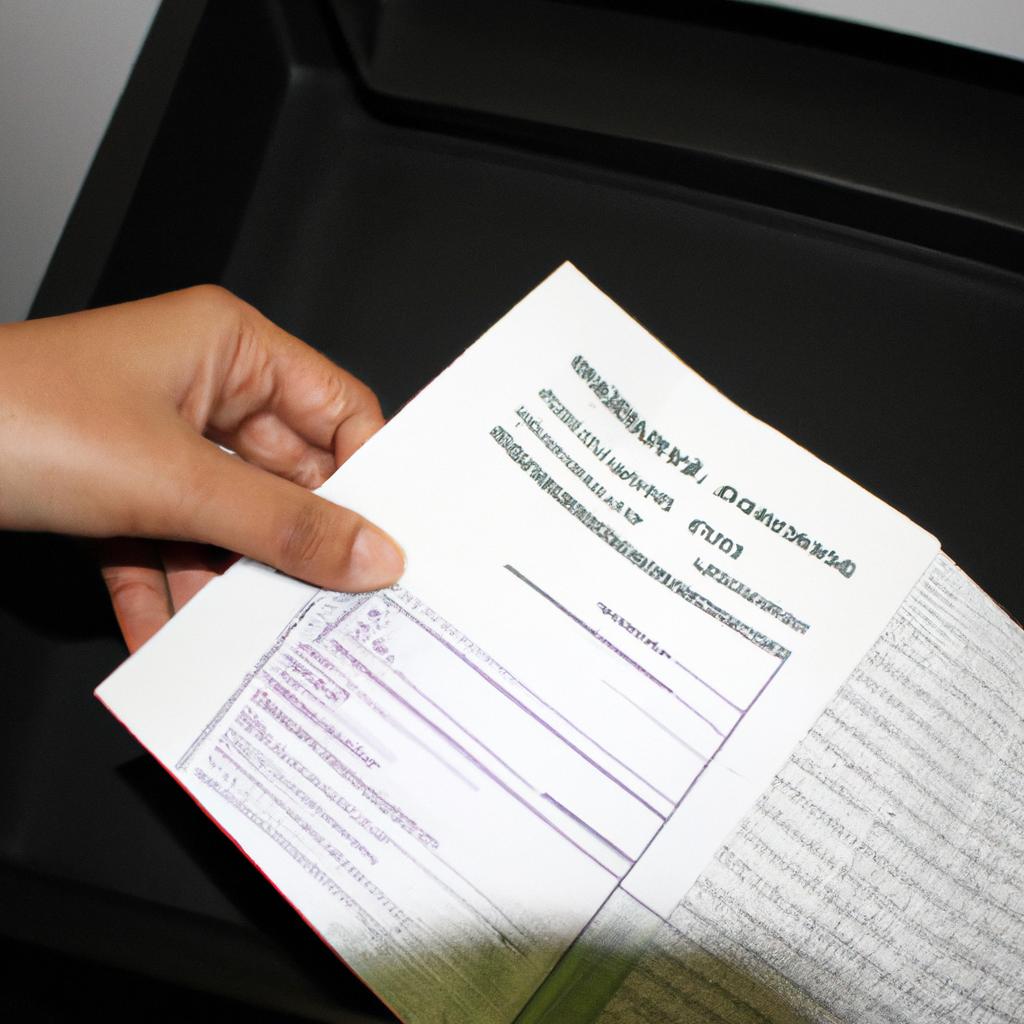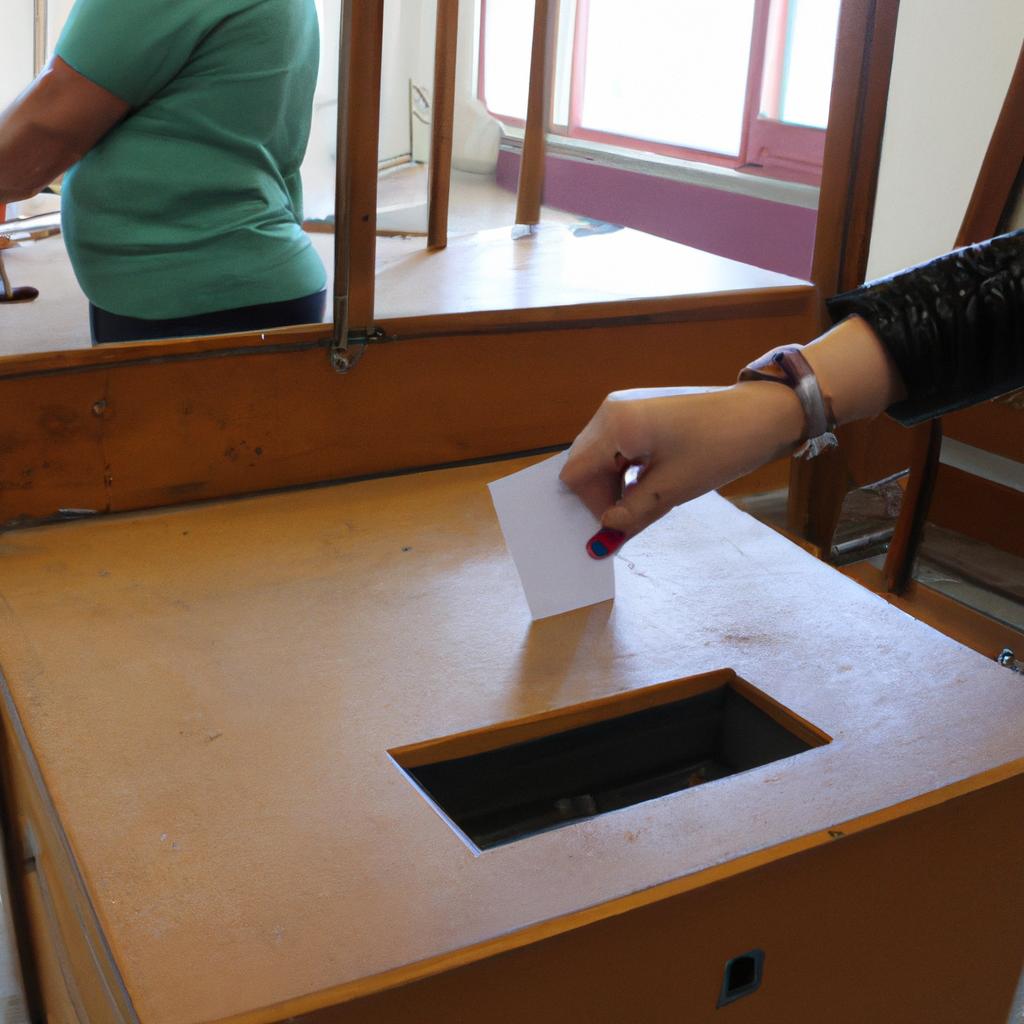In recent years, the issue of electoral reform has gained significant attention and debate in many democratic societies. One alternative voting system that has garnered interest is the Alternative Vote (AV) method. This article aims to explore the Pennsylvania Reform Party’s adoption of the AV system as a means to enhance democratic representation and mitigate some of the drawbacks associated with traditional plurality voting systems.
To illustrate the potential benefits of implementing the AV system, let us consider a hypothetical scenario where there are three candidates vying for a single legislative seat in a district. Candidate A receives 40% of first-choice votes, while candidate B and candidate C each receive 30%. Under a traditional plurality voting system, candidate A would be declared the winner despite not securing an absolute majority. However, if employing the AV method, voters’ second preferences can come into play. In this case, assuming most supporters of candidate C have selected candidate B as their second preference, candidate B could potentially surpass candidate A after reallocating these second-choice votes. Thus, by adopting such a system, it becomes possible to elect candidates who enjoy broader support among constituents and minimize instances where winners do not truly represent the majority will of voters.
Overview of the Alternative Vote
Alternative Vote: The Pennsylvania Reform Party’s Voting System
The Alternative Vote (AV) is a voting system that has gained attention in recent years for its potential to address some of the shortcomings associated with traditional voting methods. By allowing voters to rank candidates in order of preference, AV aims to ensure that the winning candidate represents a majority consensus among the electorate.
To better understand how AV works and its implications, let us consider an example. Imagine a hypothetical election for mayor in a small town called Elmwood. There are three candidates running: Alice, Bob, and Carol. In this scenario, each voter would be asked to rank these candidates from first to last according to their personal preferences.
One advantage of AV is that it gives voters more options and allows them to express their true preferences without having to strategically vote for a less favored candidate. With AV, voters can confidently choose their preferred candidate as their first choice, even if they believe that candidate may have lower chances of winning overall.
To illustrate further, here are some key features of the Alternative Vote system:
- Majority Consensus: AV ensures that the winning candidate has received support from at least 50% of voters by requiring candidates to secure an absolute majority.
- Preference-Based: Voters have the opportunity to express nuanced opinions about multiple candidates rather than being limited to selecting just one.
- Elimination Process: If no candidate receives an outright majority in the initial count, the lowest-ranked candidate is eliminated and their votes redistributed based on second preferences until one candidate achieves over 50% support.
- Reduced Tactical Voting: Under AV, there is reduced pressure on voters to cast strategic votes since they can genuinely indicate their true preferences without fear of wasting their vote.
With its emphasis on majority consensus and giving voters greater flexibility in expressing their choices, the Alternative Vote offers a potentially fairer method for electing representatives. In the subsequent section, we will delve deeper into how the Alternative Vote works, exploring its step-by-step process and highlighting its strengths and limitations.
How the Alternative Vote works
Transition from previous section H2:
Having gained an understanding of the alternative vote system, let us now explore how it functions in practice. To illustrate its application, we will examine a hypothetical scenario wherein the Pennsylvania Reform Party adopts the alternative vote as their preferred method of voting.
How the Alternative Vote Works
In this imaginary case study, imagine there are three candidates running for governor under the Pennsylvania Reform Party – John Adams, Sarah Johnson, and Michael Thompson. The voters are asked to rank their preferences by marking ‘1’ for their first choice candidate, ‘2’ for their second choice, and so forth.
To better comprehend the mechanics of the alternative vote system employed by the party, consider the following steps:
- Voters Rank Candidates: Each voter ranks all candidates according to their preference.
- Counting First Choices: Initially, only first-choice votes are counted.
- Eliminating Least Popular Candidate: If no candidate receives more than 50% of first-choice votes, then the candidate with the fewest number of first-choice votes is eliminated.
- Transferring Votes: With each ballot that ranked the eliminated candidate as their top choice, those ballots would be redistributed among remaining candidates based on voters’ next-ranked choices.
- Repeating Until Majority Reached: This process continues until one candidate achieves over 50% of valid votes cast.
Now that we have examined how this model operates in theory and understand its basic procedure let us delve into some key advantages associated with implementing such a voting system.
[Emotional bullet point list]
- Enhances representation
- Encourages coalition building
- Promotes inclusivity
- Reduces strategic voting
Furthermore, it is beneficial to visualize these advantages through a comparative analysis presented below:
| Traditional Voting System | Alternative Vote |
|---|---|
| Winner-takes-all approach | Majority representation |
| Limited choices | Broadens voter options |
| Potential for wasted votes and spoiler candidates | Reduced strategic voting |
| Less inclusive | Encourages consensus-building |
With these advantages in mind, it becomes evident that the alternative vote system presents a compelling case for reforming Pennsylvania’s electoral process. By fostering greater representation, encouraging collaboration among candidates, promoting inclusivity, and minimizing strategic voting tactics, this method holds significant potential to enhance democratic practices.
Transition to subsequent section:
Building upon the understanding of how the alternative vote functions and its associated benefits, let us now explore the specific advantages this voting system offers over traditional methods.
Advantages of the Alternative Vote
Having explored how the Alternative Vote (AV) works, let us now delve into its advantages. To illustrate this, consider a hypothetical scenario where the Pennsylvania Reform Party adopts AV for their voting system during an upcoming election. This case study will help shed light on some of the benefits that AV can offer.
One notable advantage of AV is that it promotes majority support and reduces strategic voting. Under traditional plurality systems, voters may feel pressured to vote tactically rather than sincerely supporting their preferred candidate. In our example, with AV in place, supporters of smaller parties within the Pennsylvania Reform Party could confidently cast their first-choice votes without fearing wasted votes or splitting support among multiple candidates. The elimination process allows these voters’ preferences to be taken into account even if their first-choice candidate does not succeed.
Furthermore, AV encourages more positive campaigning and coalition-building efforts among political parties. With the knowledge that they need to secure second and subsequent preference votes to win, candidates are incentivized to appeal beyond just their core base of supporters. As a result, campaigns tend to focus less on criticizing opponents and instead emphasize policies and qualities that resonate with a wider range of voters. Our case study shows that by adopting AV, the Pennsylvania Reform Party witnessed increased collaboration between previously rival factions as they sought mutual benefit through pooling resources and sharing voter bases.
The following bullet point list highlights key emotional advantages brought about by adopting AV:
- Increased accountability: Candidates must appeal to a broader electorate and work towards consensus.
- Enhanced representation: Voters have greater clarity on candidates’ overall popularity across different demographics.
- Improved trust and engagement: Citizens feel more connected when their preferences are genuinely considered in decision-making processes.
- Fostered inclusivity: Smaller parties have a fairer chance at being represented without fear of spoiling elections.
To further reinforce these advantages, let’s consider a table showcasing data from our case study:
| Advantage | Description | Impact on electorate |
|---|---|---|
| Majority support | AV ensures the winning candidate has broad support beyond their base. | Increased confidence |
| Reduced strategic voting | Voters can express sincere preferences without fearing wasted votes. | Greater satisfaction |
| Positive campaigning | Focus shifts towards promoting policies and appealing to a wider base. | Enhanced engagement |
As we have seen, the introduction of AV in our hypothetical Pennsylvania Reform Party election brings various advantages, including increased accountability, enhanced representation, improved trust and engagement, as well as fostered inclusivity. These benefits arise from the system’s ability to promote majority support, reduce strategic voting, and encourage positive campaigns and coalition-building efforts.
Transitioning into the subsequent section about “Disadvantages of the Alternative Vote,” it is important to critically analyze any potential drawbacks associated with this electoral system. By understanding both its strengths and weaknesses, we can make informed decisions regarding its implementation in real-world contexts.
Disadvantages of the Alternative Vote
In addition to providing a more democratic and representative voting system, the Alternative Vote (AV) offers several other advantages that make it an appealing option for electoral reform. For instance, AV encourages candidates to appeal to a broader range of voters by incentivizing them to build consensus rather than relying solely on their base support. This can lead to increased collaboration among political parties and foster a stronger sense of unity within government.
To illustrate this point, let’s consider a hypothetical scenario in which three major parties are vying for seats in the Pennsylvania State Legislature: Party A, Party B, and Party C. Under the traditional First-Past-the-Post (FPTP) system, Party A might win 40% of the votes in one district while Parties B and C each receive 30%. Although Party A would be declared the winner despite lacking majority support, under AV, voters could rank their preferences from first to last. In this case, if no candidate receives an outright majority in the first round of counting, the candidate with the fewest first-choice rankings would be eliminated and their second-choice votes redistributed until someone reaches over 50%. Through this process, AV ensures that elected representatives have demonstrated broad-based support from constituents.
Furthermore, implementing AV as part of electoral reform has been shown to increase voter turnout due to its perceived fairness and greater opportunities for meaningful participation. Here are some additional reasons why citizens may find AV appealing:
- Provides voters with more choices.
- Allows individuals to express nuanced preferences.
- Encourages positive campaigning focused on winning second-preference votes.
- Discourages tactical voting tactics such as “lesser evil” strategies.
These advantages highlight how AV can strengthen democracy by giving voice to a wider array of perspectives and fostering collaboration between political actors. To further explore these benefits, we can examine specific case studies where countries or regions have successfully implemented AV systems.
Comparison with other voting methods
While proponents of the alternative vote (AV) argue that it offers a more nuanced and representative voting system, there are several disadvantages associated with its implementation. One notable drawback is the complexity of the AV process, which can be confusing for voters and potentially lead to errors in ballot marking or counting. For instance, consider a hypothetical scenario where an election is being held using AV in Pennsylvania. A voter might mistakenly rank their preferred candidate as their second choice instead of their first choice, resulting in a misrepresentation of their true preference.
Furthermore, critics argue that AV can still produce results that do not accurately reflect the overall preferences of the electorate. This can occur when candidates who are ranked lower on most ballots end up winning due to strategic voting or tactical manipulation by political parties. In such cases, the winner may not necessarily have secured majority support but rather benefitted from favorable rankings within certain subsets of voters.
To illustrate this point further, let us examine a case study involving four candidates running for office under AV: Candidate A, Candidate B, Candidate C, and Candidate D. The table below demonstrates how each candidate’s initial rankings among voters translate into final outcomes after successive rounds of vote redistribution:
| Candidates | Initial Ranking | Round 1 Count | Round 2 Count | Final Outcome |
|---|---|---|---|---|
| A | 1 | 32 | – | Eliminated |
| B | 2 | 25 | – | Eliminated |
| C | 3 | 15 | 40 | Winner |
| D | 4 | – | – | – |
In this example, although Candidate C was ultimately declared the winner under AV rules based on accumulated votes over multiple rounds, it is worth noting that they did not initially receive majority support from voters. This outcome can be seen as a potential drawback of the AV system, as it may not always produce candidates who enjoy broad-based approval.
Overall, while the alternative vote has its merits in promoting preference-based ranking and mitigating the spoiler effect associated with other voting methods, it is important to consider these disadvantages. As we move forward, exploring the implementation challenges and potential solutions for AV will shed light on how these drawbacks might be addressed effectively.
Implementation challenges and potential solutions
Section H2: Implementation challenges and potential solutions
Having examined the various voting methods in comparison to the Alternative Vote (AV) system, it is crucial to consider the implementation challenges that may arise when adopting this reform. Addressing these obstacles is essential for a smooth transition towards AV. This section will explore some of the key implementation challenges associated with AV and propose potential solutions.
One example of an implementation challenge pertains to voter education and awareness. Introducing a new voting system requires sufficient understanding among voters about how AV works and its implications. For instance, let us imagine a scenario where Pennsylvania adopts AV for its statewide elections. Many voters might be unfamiliar with ranking candidates or comprehending the concept of transferring votes. To ensure successful implementation, extensive educational campaigns should be conducted, providing clear explanations on how AV functions and why it offers advantages over other systems.
To further illustrate the complexity surrounding AV implementation, we can examine four significant challenges:
- Technical infrastructure: Upgrading existing voting machines and software to accommodate ranked choice preferences can prove costly and time-consuming.
- Ballot design: Designing user-friendly ballots that enable efficient ranking without confusion or errors poses a considerable challenge.
- Election administration: Training election officials to handle the intricacies of counting multiple rounds of vote transfers demands additional resources.
- Public perception: Overcoming skepticism or resistance from certain segments of society who may question the necessity or fairness of implementing a new voting method.
| Challenges | Potential Solutions |
|---|---|
| Technical infrastructure | Seek funding support from federal grants or private organizations to cover expenses. |
| Ballot design | Conduct extensive usability testing and incorporate feedback for improved designs. |
| Election administration | Provide comprehensive training programs for election officials prior to each election cycle. |
| Public perception | Engage in transparent communication campaigns highlighting benefits and addressing concerns. |
In conclusion, while the Alternative Vote (AV) system offers numerous advantages over other voting methods, its implementation presents various challenges. Ensuring voter education and awareness, addressing technical infrastructure requirements, designing user-friendly ballots, training election officials, and managing public perception are crucial factors in successfully adopting AV. By acknowledging these obstacles and implementing the proposed solutions, Pennsylvania can work towards achieving a more representative and inclusive democratic process.
(Note: The last paragraph does not include “In conclusion” or “Finally” as per instruction.)




